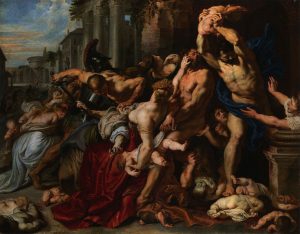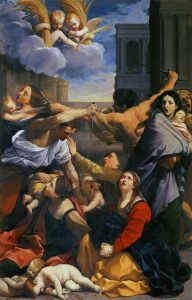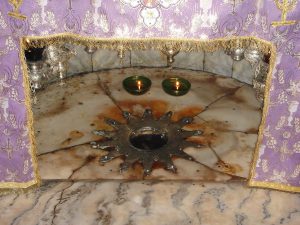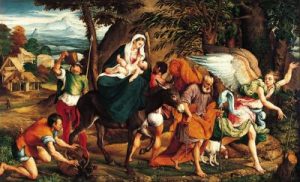UCC’s pastor, the Rev. Dr. Art Suggs, shared this about Childermas:
“In 33 years as a pastor, I’m doing something right now that I’ve never done before: I’m preaching on a passage and a topic generally ignored or avoided.

December 28 or 29, depending on the Roman Catholic or Orthodox calendar, is the relatively minor holiday feast day called Childermas.
In the same way that Christmas is Christ Mass, a mass celebrating the birth of Christ, Childermas recognizes children, but specifically the children who were massacred by Herod.
The significance of it comes from one line I read years ago, where it said, “The significance of the day is that it is the day Jesus became a refugee.”

“Imagining the fear that Jesus’ parents must have experienced, the Bible says that Joseph was warned in a dream about Herod’s intention to kill male babies two years old and younger.”
“But in a day prior to mass communications, how would one know, if you lived in Bethlehem, that such an order had been given?”
“A rumor would likely spread that a male baby would grow up to become King of the Jews, and he would usurp power from Herod. The word would spread one family at a time, and hopefully it would spread faster than Herod’s goons could move from house to house.”
“Learning of the decree, one person telling another, do you fight?”
“No, you cannot outweigh the forces of evil, so you either hide or flee, and Joseph and Mary chose to flee.”

Rev. Suggs went on to speak of the Church of the Nativity and his visit there in 2005 — the Grotto of Christ’s birth, as it’s called — and how there are two sides to this story.
On one hand (or side), this story is only mentioned in the Gospel of Matthew, leading “some scholars (to) suspect that the lack of supporting backup is what’s called a “contrived fulfillment of prophesy.” They’re trying to make that linkage (between Moses and Jesus) in the Gospel of Matthew. Perhaps flim-flammers are supporting a specious story to make it look as though Jesus was a second Moses. So that’s one side of the story,” said Rev. Suggs.
“The other side of the story is this. I wouldn’t put it past Herod to give out such an order. Get a load of this: He murdered three of his sons; he murdered his mother-in-law; he murdered his second wife; he murdered his brother-in-law; he murdered what is estimated at 300 military commanders.”

“And as well, he murdered an unknown number of Pharisees; they didn’t bother to count because they were not as important as the military commanders. But you can bet it was more than 300. So would he give out an order like this? You tell me.”
“What I asked myself to think about on this Sunday morning is why we’re looking at this notion, this story that’s happily ignored in our scriptures.”
“Who in their right mind wants to preach on two grottos, the false story of the Nativity and the killing of babies? I haven’t wanted to do that for all of my career, but something snapped this year, and I thought this might be the time to look at it.”
In the full sermon, Rev. Dr. Suggs shares why the world is still a brutal place for children … and why there is profound, statistically proven reason for hope.
Download and read the full Childermas: When Jesus Became a Refugee here.
